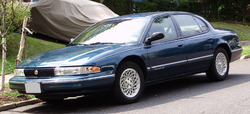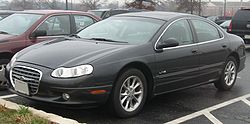- Chrysler LHS
-
Chrysler LHS 
Manufacturer Chrysler Corporation
DaimlerChryslerProduction 1994–2001 Assembly Brampton, Ontario, Canada Predecessor Chrysler Imperial
Chrysler New YorkerSuccessor Chrysler Concorde (Moniker & Refresh) Class Full-size Body style 4-door sedan Layout FF layout Platform Chrysler LH platform The Chrysler LHS is a full-size, front wheel drive car based on the Chrysler LH platform.
Having been praised throughout its production run as offering a blend of high-end features, along with solid performance, the LHS was marketed as a rival to other cars costing thousands more. The first generation LHS offered an overall package (of both comfort and performance) very reminiscent of a higher end European car. Many American automotive journalists stated that the car could be easily mistaken for something German. This was just a few years before Chrysler Corporation's partnering with Daimler-Benz.
Contents
Design background
The LHS's design can be traced to 1986, when designer Kevin Verduyn completed the initial exterior design of a new aerodynamic concept sedan called Navajo. The design never passed the clay model stage.
It was also at this time that the Chrysler Corporation purchased bankrupt Italian sports car manufacturer Lamborghini. The Navajo's exterior design was reworked and became the Lamborghini Portofino, released as a concept at the 1987 Frankfurt Auto Show. The Portofino was heralded as a design triumph, setting in motion Chrysler's decision to produce a production sedan with the Portofino's revolutionary exterior design, called "cab-forward".
The cab forward design was characterized by the long, low slung windshield, and relatively short overhangs. The wheels were effectively pushed to the corners of the car, creating a much larger passenger cabin than the contemporaries of the time.
Design of the chassis began in the late 1980s, after Chrysler had bought another automaker: American Motors Corporation (AMC) in 1987. During this time, Chrysler began designing the replacement for the Dodge Dynasty and Chrysler Fifth Avenue as well as a potential Plymouth. The initial design of Dodge's LH bore resemblance to the Dynasty, and this design was scrapped entirely after François Castaing, formerly AMC's Vice President of product engineering and development, became Chrysler's Vice President of vehicle engineering in 1988. The new design, under Castaing's leadership, began with the Eagle Premier, also sold later as the Dodge Monaco.
The Premier's longitudinal engine mounting layout was inherited, as was the front suspension geometry, and parts of the braking system. The chassis itself became a flexible architecture capable of supporting front or rear-wheel drive (designated "LH" and "LX" respectively).
The chassis design was continually refined throughout the following years, as it underpinned more Chrysler prototypes: the 1989 Chrysler Millennium and 1990 Eagle Optima.
The transmission was inspired by the Premier's Audi and ZF automatics. Borrowing heavily from Chrysler's A604 (41TE) "Ultradrive" transversely-mounted automatic, it became the A606 (also known as 42LE). This "Ultradrive" transmission however was not without critics as The New York Times reported on January 25, 1991 that Consumers Union would publish in the February 1991 issue of the magazine Consumer Reports a warning for consumers to NOT purchase a vehicle with this "Ultradrive" transmission citing poor reliability and safety hazards.
By 1990, it was decided that the new technologically-advanced car would need a new technologically-advanced engine to power it. Until that time, the only engine confirmed for use was Chrysler's 3.3 L pushrod V6, which would be used in the three original LH cars, the Intrepid, Vision, and Concorde, in base form. The 3.3 L engine's 60° block was bored out to 3.5 L, while the pushrod-actuated valves were replaced with SOHC cylinder heads with four valves per cylinder, creating an advanced 3.5 L V6 optional in the three smaller cars, but standard in LHS and New Yorker.
The general LH appearance, still based on the cab forward exterior design of the 1987 Lamborghini Portofino concept, with its aerodynamic shape, made for little wind noise inside this large car. This sleek styling gives the LH cars a low drag coefficient which was ahead of its time.
The "Second Generation" LH car design was introduced in 1996 as the Chrysler LHX Concept Car. This concept vehicle had large 20" wheels, a centrally located instrument cluster and a closed-circuit television system within the windshield pillars replacing conventional rear view mirrors. The wheelbase was expanded to 124 inches (3,100 mm) to allow for rear passenger supplement restraints, rear occupant entertainment center and storage compartment.
First generation: 1994–1997
First generation 
Production 1993–1997 Model years 1994–1997 Engine 3.5 L EGJ V6 Transmission 4-speed 42LE automatic Wheelbase 113.0 in (2,870 mm) Length 207.4 in (5,268 mm) Width 74.4 in (1,890 mm) Height 1994: 55.7 in (1,415 mm)
1995-97: 55.9 in (1,420 mm)Related Dodge Intrepid
Chrysler Concorde
Chrysler New Yorker
Eagle VisionOriginally released in 1994, a year after the Chrysler Concorde, Dodge Intrepid and Eagle Vision were released, the LH 207 (Chrysler LHS and New Yorker) used a version of the LH platform with a five-inch (127 mm) longer body, and took the place of the Imperial as the largest and most high-end car in Chrysler's range and viewed as its "flagship" model. While the wheelbase of all the LH models remained the same, the 5-inch (130 mm) longer body allowed the engineers to push the rear seat even farther back. This gave the LHS an almost limo-like rear seat room, analogous to the various stretched "L" models from BMW or Mercedes. A very similar New Yorker model was also built as a replacement for the New Yorker Fifth Avenue and New Yorker Salon. It shared much in common with LHS, only with a less monochromatic appearance in trim and body cladding, and a softer tuned suspension. It also featured many of LHS's standard features as "optional". From 1994 on, all three Chrysler LH models used the mid-level "Touring" suspension. An even stiffer "Performance" setting was an available option on the Dodge Intrepid and Eagle Vision.
The Concorde, which differed substantially more, was seen as the base full-size Chrysler. The five-passenger LHS was differentiated from its counterpart chrome-trimmed sibling, the six-passenger Chrysler New Yorker, by a floor console and shifter, an upgraded interior and a sportier image. The New Yorker was dropped in favor of a six-passenger option on the 1997 LHS. The LHS received a minor face change in 1995 where the Pentastar was changed in favor of Chrysler's current medallion logo.
Being the top-of-the-line Chrysler, many features came standard on the LHS — features optional on its siblings. Some of these options included a 3.5 L EGJ 24-valve 214 hp (160 kW) V6 engine, body-colored grille, side mirrors and trim, traction control, aluminum wheels, integrated fog lights, and 8-way power adjustable front seats, premium sound systems with amplifiers, and automatic temperature control. Like the New Yorker, leather seats were an option, a velour-like cloth coming standard. The LHS's leather mimicked the soft, gathered style of its cloth seats, and projected a more expensive look than the New Yorker's more traditionally styled leather.
The headlamps on the 1994 models were very poorly designed and many owners complained about their poor brightness. Chrysler rushed the redesign into the production for 1995 model year. Chrysler's LHS used a projector-style headlight beam, something that was still somewhat uncommon for its time.
The LHS was sold in Europe on a special order basis as it featured rear amber turn signals, side turn signal repeaters, and headlamps that incorporated different lens geometry and bulbs.
The first generation LHS was praised by motoring journalist Jeremy Clarkson, who is well known for criticizing American automobiles but described the LHS as "by global standards, right up there with the best."[1]
Second generation: 1999–2001
Second generation 
Production 1999–2001 Engine 3.5 L EGJ V6 Transmission 4-speed 42LE automatic Wheelbase 113.0 in (2,870 mm) Length 207.7 in (5,276 mm) Width 74.4 in (1,890 mm) Height 56.0 in (1,422 mm) Related Dodge Intrepid
Chrysler 300M
Chrysler ConcordeThe LHS was dropped after the 1997 model year in anticipation of a new, redesigned LHS, released for 1999. As was the case before, the second generation LHS occupied its niche as Chrysler's high-end car, although its interior provided no more space than the slightly longer-nosed Concorde. The differences between the second-generation LHS and the Concorde were far fewer and limited mostly to fascias and equipment levels. Also released with the new LHS was the Eagle Vision replacement, the Chrysler 300M. The addition of the 300M once again gave Chrysler three full-sized models, all based on the LH platform. The slightly smaller 300M ended up costing more than the LHS, but became more popular, as did the less expensive Concorde. Due to the restyling, the LHS interior felt slightly more cramped than the previous model. The side windows were more aggressively curved into the roof, reducing the space between the upper portions of the windows and the sides of the occupants' heads. While all the stated interior measurements equaled or exceeded the first LHS's, the new car's interior lost its predecessor's limo-like feel.
For 2002, Chrysler quietly dropped the LHS nameplate from its lineup, with the 2002-2004 Concorde taking on the LHS's front and rear fascia styling, as well as the LHS styled interior on the Concorde Limited. The 2002-2004 Concorde LX and LXi retained the same interior as the 1998-2001 Concorde.
LHS base prices
First generation
- 1994 • $30,283
- 1995 • $29,595
- 1996 • $30,225
- 1997 • $30,225
all figures in U.S dollars
Second generation
- 1999 • $28,950
- 2000 • $28,340
- 2001 • $28,680
all figures in U.S dollars
References
External links
- Allpar.com - Chrysler LHS on Allpar.com
- Allpar.com - Second generation LHS
- Chrysler.com - 2001 Chrysler LHS homepage, courtesy of Internet Archive
Chrysler timeline, 1970–present Type 1970s 1980s 1990s 2000s 2010s 0 1 2 3 4 5 6 7 8 9 0 1 2 3 4 5 6 7 8 9 0 1 2 3 4 5 6 7 8 9 0 1 2 3 4 5 6 7 8 9 0 1 2 Compact LeBaron PT Cruiser Town & Country Town & Country Mid-size LeBaron (2-dr) Sebring (2-dr) Sebring (2-dr) LeBaron conv. Sebring conv. Sebring conv. Sebring conv. 200 conv. E-Class LeBaron GTS LeBaron (4-dr) Cirrus Sebring (4-dr) Sebring (4-dr) 200 (4-dr) LeBaron Fifth Avenue New Yorker Full-size Newport Newport Fifth Avenue Concorde Concorde 300 300 New Yorker New Yorker New Yorker New Yorker New Yorker 300M Town & Country Imperial LHS LHS Sports Laser Conquest Prowler Crossfire Crossover SUV Pacifica SUV Aspen Minivan TEVan Voyager Voyager Town & Country Town & Country Town & Country Town & Country Town & Country Limousine Executive Personal luxury Cordoba Imperial GT TC See also: List of Chrysler vehicles Categories:- Chrysler vehicles
- Front wheel drive vehicles
- Full-size vehicles
- Sedans
- 1990s automobiles
- 2000s automobiles
- Vehicles introduced in 1994
Wikimedia Foundation. 2010.

